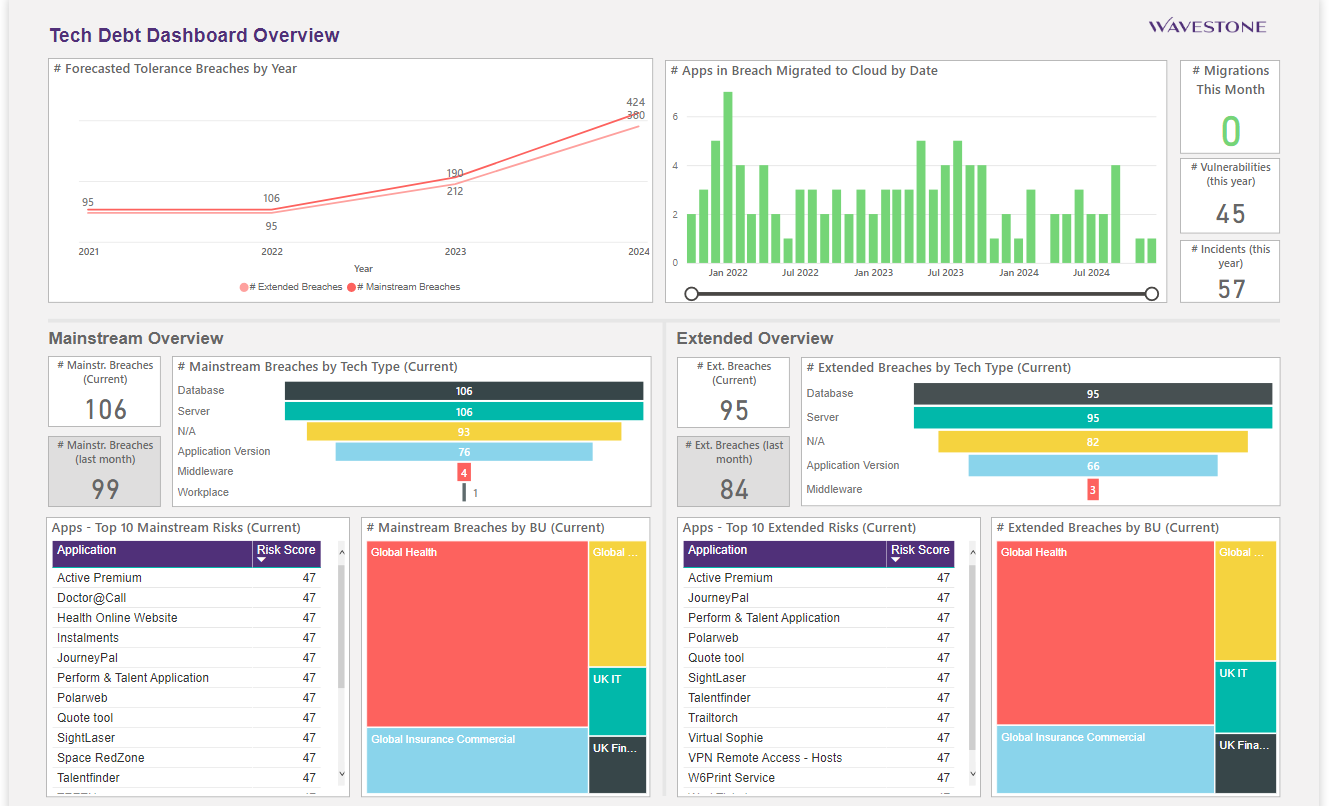Technical Debt Remediation and Visualisation for a Multinational Insurance Organisation
With multiple different business units managing and using different technology assets (applications, servers, databases etc.) – a multinational insurance organisation required maintenance, support, and remediation processes in place for all these assets in case of a disruption. An internal audit point flagged that the client was not compliant with their technical debt processes; they had no real-time view on the technical debt level across these different business units and did not have a transparent understanding of which technology assets were used and managed by each business unit.
The management of technical debt, especially the risks resulting from obsolescent technology is a very topical issue for multiple of Wavestone’s clients. Obsolescent technology can result in operational disruptions to the organisation leading to entity-wide downtime, inability to serve clients, and deteriorated end-user experience.
How did Wavestone help?
Wavestone took a two-phased approach to support the client:
The first phase focused on devising a more strategic risk view of technical debt with a clearly defined risk tolerance. This involved developing a strategic view of technical debt with the relevant stakeholders so that informed decisions could be made on remediation priorities. This was followed by establishing the client’s risk tolerance that was to be aligned with the wider IT Risk Impact Framework. Following the assessment, Wavestone performed a Gap Analysis within Risk & Controls to determine ways in which the organisation can effectively manage technology obsolescence, and then improved the accuracy of the data elements through workshops with the different business units.
Now that the client had a coherent view of their current state of technical debt, the second phase focused around enabling the Risk & Controls team to analyse their current and future states more interactively so that they could better prepare for future scenarios. This was achieved by developing a dynamic and automated dashboard that presented multiple views of their technology estate across several segments as well as the ability to forecast the technical debt profile over a number of years. This in turn greatly improved the Risk & Controls team’s capability to produce regular reporting of their technical debt status and has now transitioned into a BAU process.
Example of a technical debt dashboard
The relationship with our Client
Wavestone deployed a team of an Engagement Lead and Delivery Consultant, with support of a Partner to deliver the two phases. The priority during delivery was to ensure that the client stakeholders were regularly updated and included in the decision-making processes. As well as providing the client with the required deliverables to resolve the audit issue, Wavestone were determined in providing something that could be used as part of their BAU processes, offering long term value for the organisation. Along with the regular workshops with the various business units, Wavestone provided thorough handover sessions for both the technical debt profiles and dynamic dashboard to ensure everything was operational following completion of the engagement. This collaborative approach ensured the engagement was finished by the set date.

Head of Risk and Control
Multinational Insurance Organisation
Wavestone did an excellent job both from stakeholder management as well as technical delivery perspective. The engagement involved working with a wide range of stakeholders, some of which can be challenging to manage expectations. Wavestone’s determined, professional style won them over and the work is held in high regard. We also closed the related audit action and submitted evidence to close the final action re: technical debt management. I think very highly of Wavestone and would welcome the opportunity to work with them again.
The results
Following completion of the project, the organisation now has full visibility of their technical debt profiles of the various business units, as well as a fully automated dashboard that provides transparent current and future views. Our client was able to resolve the audit incompliance issues, while also improving their regular reporting within their BAU processes.
The key success factors for this engagement were continuous collaboration with client stakeholders to ensure that the deliverables were in line with the requirements; and availability of data so that obsolescence scores could be successfully compared to the devised risk appetites.




